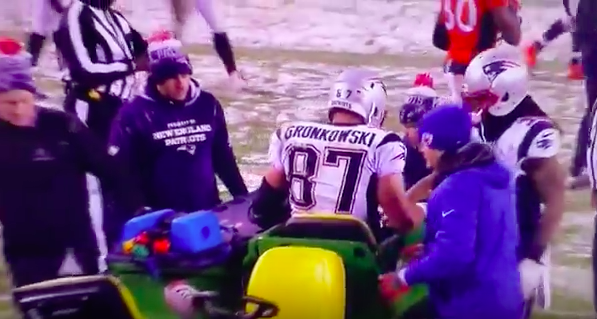Rob Gronkowski’s Knee Injury Is a Result of NFL Player Safety Measures

NFL
Over the last several years, the NFL has rightfully placed an emphasis on eliminating hits to the head. But one of the consequences of those player safety measures is that defenders now have no choice but to hit low.
For the second time in three seasons, Rob Gronkowski was carted off the field Sunday because an opposing player hit one of his knees. Late in the fourth quarter of the Patriots’ 30-24 overtime loss to the Broncos, safety Darian Stewart drove his body into Gronkowski’s right knee to break up a pass. The sequence was reminiscent of what happened in December 2013, when former Browns safety T.J. Ward—who coincidently now plays for Denver—hit Gronkowski low and knocked him out for the rest of the year.
Rob Gronkowski’s knee was injured on this play. #NEvsDEN https://t.co/cpKJs6qGJB
— NFL (@NFL) November 30, 2015
Fortunately for the Patriots, Gronkowski is only expected to miss one game at most. But Stewart’s hit is a reminder that Gronkowski’s knees are an easy target for defenders. As Ward put it two years ago, it’s the only way to bring the 6-foot-6, 265-pound Gronkowski down with all of the rule changes.
“It’s kind of being caught between a rock and a hard place,” Ward said. “It’s a decision you have to make, but you have to follow the rules at the same time. When they set the rule, everyone knew what was going to happen. This can happen if you have those types of situations. It’s pretty much inevitable, and they forced our hand with this one.”
In today’s NFL, it’s illegal to tackle players in the head or neck area. As a result, defenders must come up with other ways to stop receivers. But the cruel irony is, though knee injuries are far less dangerous in the long run than concussions, they often take longer to recover from in the short-term. Tom Brady acknowledged this inconvenient truth when he was asked about Gronkowski after the game.
“I hate to see it, but it’s really the only way for defenders to hit now,” Brady said. “I bet you if you asked probably a lot of the players, they’d probably rather you go high than low. But when you go low, that’s what happens.”
The links between football and head trauma are indisputable. In September, researchers said they identified the degenerative brain disease known as chronic traumatic encephalopathy (CTE) in 96 percent of deceased NFL players they’ve examined. Last Wednesday, Hall of Fame quarterback Frank Gifford’s family said he suffered from CTE as well after his playing days were over.
Though Gronkowski’s cognitive health would’ve been in danger if he were hit in the head Sunday, he might’ve stayed in the game—just like Julian Edelman did in the fourth quarter of last season’s Super Bowl. Edelman wound up catching the game-winning touchdown pass, whereas Gronkowski was forced to watch the Patriots lose their first game of the year from the locker room.
That’s a trade-off Gronkowski and other players should be willing to make. But rationality doesn’t always jive with the hyper-competitive world of professional football. It’s all about winning games, health and wellbeing be damned.


